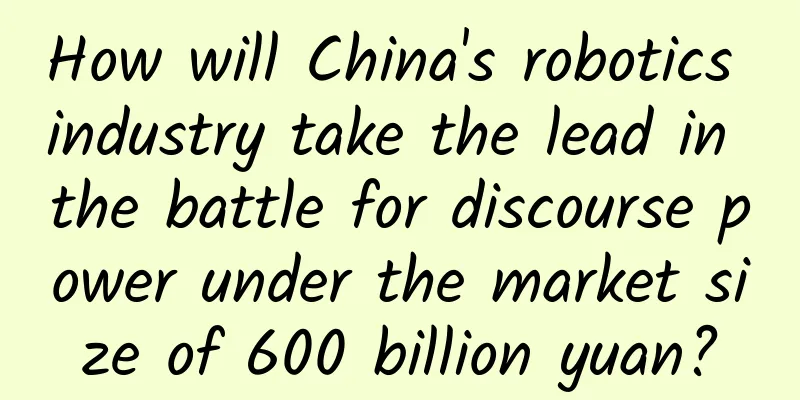How will China's robotics industry take the lead in the battle for discourse power under the market size of 600 billion yuan?

|
Artificial intelligence and the robotics industry have been labeled as hot topics in the wave of technological change in 2017, and countries have also launched a technological competition under the spotlight. Especially in the Internet circle, people have begun to believe in the saying "He who has artificial intelligence will rule the world." Behind the hot industry and market, the domestic robotics industry has also emerged with big and small concerns. With the gradual disappearance of China's demographic dividend and the requirements of "Made in China 2025", it has become a general trend for robots to replace manual labor. Therefore, the various problems that have gradually emerged under the market-oriented development cannot be ignored. Domestic sales rank first in the world, but imports account for 90% Although my country's robotics industry started late, it has maintained a high-speed development trend, thanks to the large number of domestic industrial robots. With the continuous increase in labor costs in recent years, the phenomenon of "machines replacing people" in the industrial field is common. In contrast, the prosperity of the industrial robot market has led to the domestic priority development of the robotics industry. According to relevant statistics, there are 28 provinces in China that focus on the development of the robotics industry, more than 40 robotics industrial parks, and more than 500 robotics companies. Under the dual favorable conditions of market and policy, the domestic robot market is rapidly heating up. It is estimated that in the next 10 years, the total scale of China's industrial robot market will reach a considerable 600 billion yuan. Since 2013, the use of industrial robots in my country has increased significantly. In 2016, the total sales volume reached 89,000 units, a year-on-year increase of 26.6%. Among them, the cumulative sales of domestic industrial robots reached 29,000 units, a year-on-year increase of 30.9%. The number of industrial robots installed reached 85,000 units, exceeding 30% of the number of new industrial robots in the world. At present, there are more than 1.5 million industrial robots in use around the world. By 2018, this number will exceed 2.3 million, of which 1.4 million are in Asia, accounting for more than half. This means that 3 out of every 10 industrial robots in the world are used in China. However, although my country's industrial robot usage has ranked first in the world for five consecutive years, in sharp contrast, in the huge robot consumer market, Chinese local brand robots only account for 4%. It can be said that my country is currently in the critical period of "China's Intelligent Manufacturing". At present, promoting the integration of emerging technologies and manufacturing technologies, including artificial intelligence and robot applications, has become the main direction of my country's manufacturing transformation and upgrading. Since the "Robotics Industry Development Plan (2016-2020)" proposed specific goals for 2020, my country's new generation of robotics technology has achieved breakthroughs in various fields, but the premise of innovative application still needs to face obstacles such as the lack of core technologies and the training of relevant talents. The talent gap exceeds millions, and mastering core technologies is the key According to the Global AI Talent Report, only 38.7% of Chinese AI practitioners have worked in the field for 10 years, while the proportion of those in the United States with more than 10 years of experience has reached the highest in the world at 71.5%. However, although there is a huge gap between my country and the United States in the total number of AI talents, China has a clear advantage overall and has a better development prospect. The advantage of Chinese AI talents is that most of them are highly educated, with 62.1% of them having a master's degree or above, ahead of the 56.5% in the United States. In terms of personnel distribution, more than 70% of the American AI basic talents are too concentrated. China's AI technology and application talents are more widely distributed, especially in the fields of robotics, image recognition, precision marketing and autonomous driving. However, in addition to the talent advantage, the disadvantages of the core of my country's industrial development are also obvious. The development of industrial robots has become a pillar-level link in domestic development. However, if my country's related industries want to make a breakthrough in essence, they need to pay more patience and investment in core technical strength. For example, the field of surgical robots, which only represents a small part of the market but can reflect the reality of the entire industry. The United States now has 3,000 surgical robots, and my country has only 60. However, this market can reach tens of billions, provided that the corresponding key technologies are mastered. However, for a long time, the relevant technologies have been in the hands of a few overseas companies such as Japan's FANUC, Japan's Yaskawa, Germany's KUKA and Switzerland's ABB. This undoubtedly led to overseas companies easily seizing most of my country's robot market share. Secondly, due to the lack and imperfection of core technologies, the domestic robot industry can only allow overseas upstream companies with absolute discourse power to arbitrarily slaughter and earn excess profits from it. However, the good news is that the fierce competition between foreign and domestic robot suppliers will, to a certain extent, encourage more Chinese related industries to enter the market. In addition to the promotion of policies and other aspects, it is expected that by the end of this year, the number of robots in China will exceed 400,000, and the future growth potential of the Chinese market is huge. As a winner of Toutiao's Qingyun Plan and Baijiahao's Bai+ Plan, the 2019 Baidu Digital Author of the Year, the Baijiahao's Most Popular Author in the Technology Field, the 2019 Sogou Technology and Culture Author, and the 2021 Baijiahao Quarterly Influential Creator, he has won many awards, including the 2013 Sohu Best Industry Media Person, the 2015 China New Media Entrepreneurship Competition Beijing Third Place, the 2015 Guangmang Experience Award, the 2015 China New Media Entrepreneurship Competition Finals Third Place, and the 2018 Baidu Dynamic Annual Powerful Celebrity. |
<<: Self-driving cars become vending machines? Smart cars open up a new shopping platform
Recommend
Samsung should fight Apple instead of Chinese manufacturers
Samsung's Galaxy S6 and Galaxy S6 Edge are in...
Baidu bidding promotion keyword ranking query method, a must-learn for novices!
For bidders, after setting the bid, the most impo...
How much does it cost to rent a 300g defense server in China?
A high-defense server is like putting a layer of ...
ThunderSoft and Amazon Web Services (AWS) work together to accelerate the deployment of smart industrial AI. ADC system fully integrates Amazon SageMaker
On June 4, 2020, when Amazon SageMaker machine le...
All-solid-state batteries are safer and have higher energy density, but American academicians believe that they will not be available before 2030
Recently, Wang Chaoyang, a member of the U.S. Nat...
Flu ≠ cold! Don’t confuse them anymore! You must know these differences →
Although medicine has made great progress in the ...
To spread toxic content, you must master the art of social copywriting (Part 1)
Today’s media is everyone, and today’s communicat...
If you sit for a long time all day and lack exercise, you should be careful...this disease has already targeted young people!
《Cotton Swab Medical Science Popularization》 Mi Y...
[Kinetic Taping Technology] Kinesiology Taping Video
[Kinetic Taping Technology] Introduction to Kines...
How to successfully transform online and achieve growth during the epidemic?
The sudden outbreak of the new coronavirus caught...
His life goal is to obey the needs of the country, but why did he refuse promotion twice?
Du Xiangwan, 83 years old this year He is an acad...
Musk once again criticized LiDAR as a wrong solution, but is pure visual intelligent driving really right?
Regarding intelligent driving solutions, there ha...
PPI April 2021 iPad Illustration Course [HD Quality] Course Catalog
01Introduction to Software Basics.mp4 02 Line dra...
SEO website optimization, do you pay attention to the website information architecture?
In the daily work of SEO, if someone talks about ...
![Change your wealth beliefs and live a rich life Lai Qiukai's wealth thinking upgrade course [Complete] Baidu Cloud Download](/upload/images/67cc229025eaa.webp)








